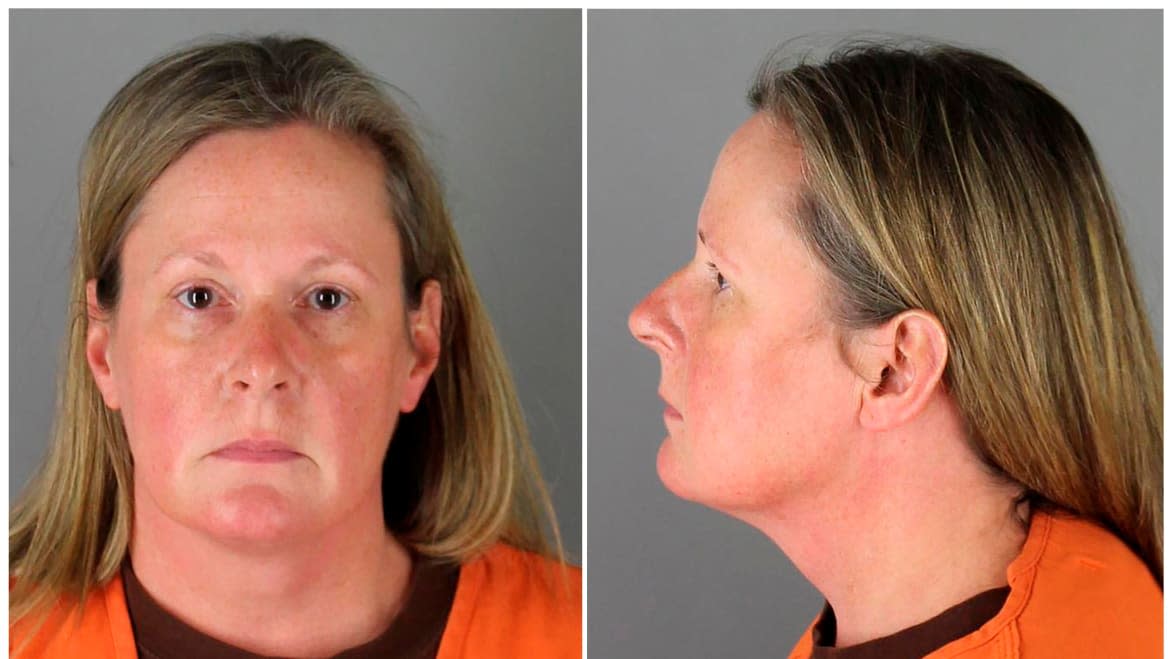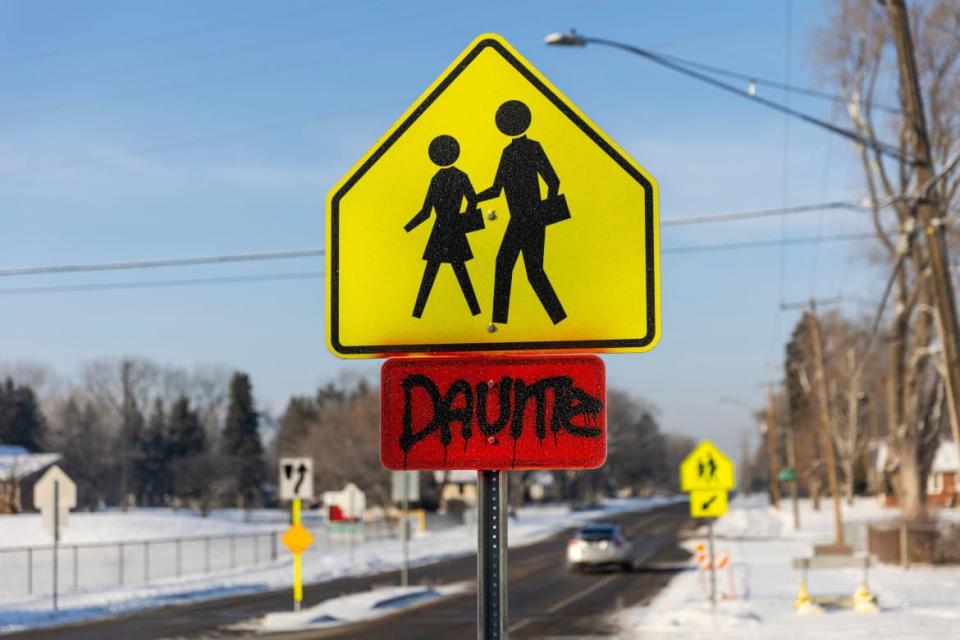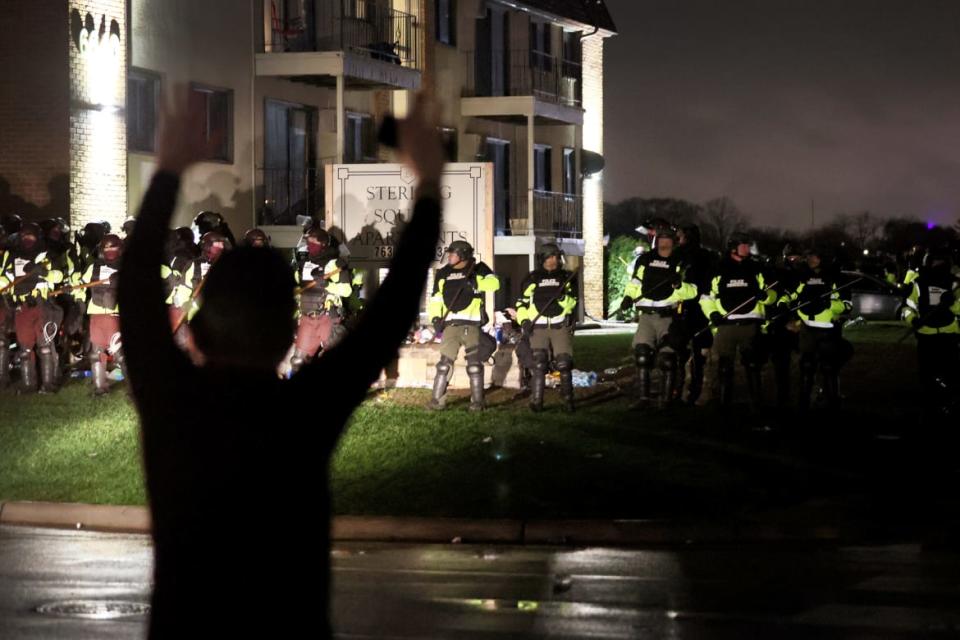The Chauvin Case Was a Slam Dunk. The Kim Potter Trial Could Be a Fiasco.

- Oops!Something went wrong.Please try again later.
For Amity Dimock-Heisler, Minneapolis cop Derek Chauvin murdering George Floyd was personal.
The viral video of the crime sent shockwaves through social media, and erupted long-simmering anger about racial injustice and police brutality in the United States. For weeks, people took to the streets to protest, Floyd’s final pleas to breathe became a rallying cry, and the world zeroed in on past police killings, including in the Minneapolis area.
That included the August 2019 death of Dimock-Heisler’s 21-year-old son, Kobe.
“I had been fighting for months for people to pay attention to Kobe’s case and it was initially frustrating that George Floyd’s death was all over the news and not my son’s,” Dimock-Heisler told The Daily Beast. “But then, people started paying attention to our story and the stories of other parents or partners who lost loved ones to the police. Suddenly, we were getting truly noticed.”
That spotlight remained for months after Floyd’s tragic death—and even as Chauvin faced a jury before the world last April. But then, amid a trial that had massive stakes for law enforcement in America, white Brooklyn Center police officer Kim Potter fatally shot 20-year-old Black man Daunte Wright after allegedly mistaking her handgun for a taser during a traffic stop in the Minneapolis suburb.
Wright’s case sparked days of protests in the area and, critics argued, proved that the state had not done nearly enough to overhaul de-escalation and use-of-force policies. But for Dimock-Heisler, whose son was shot six times by two Brooklyn Park police officers responding to a “disturbance call” at his grandparents’ house, Wright’s death at the hands of now-ex cop Kim Potter’s colleagues was a more personal blow.
“I didn’t immediately recognize [Potter],” Dimock-Heisler said about when she learned of Wright’s death. “Then, someone told me that Potter arrived at the scene after my son’s death and advised the other officers to get in their cars, turn off their body cams, and not talk to each other. I was floored. What are the odds.” No officers were charged in the incident, with prosecutors concluding that Kobe Dimock-Heisler—who had a history of mental illness—was a danger to them.
“Now, I am terrified at the thought of her not getting convicted,” his mother added. “We need some justice.”
The trial against Potter for the April 11 traffic stop that began over expired car tabs and ended with Wright suffering a fatal wound to the chest began on Wednesday, just over seven months after Chauvin was convicted for murdering Floyd. But unlike Chauvin’s trial, which was widely viewed as a sure-thing conviction, Minnesota laws and Potter’s insistence—potentially bolstered by video—that the shooting was an accident complicates her case.
Potter, a 48-year-old who resigned from the force over the shooting after 26 years on the job, is facing first-degree manslaughter and second-degree manslaughter charges in connection with Wright’s death. She has pleaded not guilty, but throughout the trial, prosecutors and defense lawyers were expected to agree that the deadly incident was accidental.
Mom Rips Cops After Former New Orleans Saints Defensive Lineman Dies in Police Custody
Prosecutors, however, insist that Potter was criminally negligent—while the former cop’s defense team insists Wright was resisting arrest and use of force was warranted.
“This case is about this defendant Kimberly Potter betraying her badge, and betraying her oath, and betraying her position of public trust. And on April 11 of this year, she betrayed a 20-year-old kid,” Minnesota Assistant Attorney General Erin Eldridge said during her opening statements Wednesday.
But Ted Sampsell-Jones, a professor at Mitchell Hamline School of Law in St. Paul, said the state’s argument might be hard to prove given the body-camera footage.
“The fundamental problem for the prosecution is that the video evidence supports the defense claim that this was an accident,” Sampsell-Jones told The Daily Beast. “Before she fired, she yelled ‘taser! taser! taser!’—which is what officers are trained to say before they use a taser, so other officers can move.”
Sampsell-Jones added that for most people who watched now-infamous body-camera footage of the incident, it’s clear Potter made a “stupid and tragic mistake”—a conclusion that might make it difficult for prosecutors to convince a jury she broke the law.
“That will make it difficult to convict. Not necessarily impossible, since the charges can be founded on at least some forms of reckless accidents,” Sampsell-Jones said. “Chauvin’s case ended up being a slam dunk. This one is shaping up to be much tougher.”
To prove the first-degree manslaughter charges under Minnesota law, prosecutors need to show that Potter caused Wright’s death with “reckless handling or use of a firearm so as to endanger the safety of another with such force and violence that death or great bodily harm to any person was reasonably foreseeable.” To prove the second-degree charge, prosecutors need to show that Potter “caused an unreasonable risk” by using a firearm.
Simply put, prosecutors do not need to prove that Potter intended to kill Wright, only that she was reckless in her actions. But to do so, prosecutors also need to pass a higher threshold to prove culpable negligence, which is described in Minnesota law as an “unreasonable risk, and consciously [taking] chances of causing death or great bodily harm to another.”
“For second-degree manslaughter, the statute says that she must consciously disregard a risk of death or great bodily harm,” Sampsell-Jones said, adding that “great bodily harm is defined in the law as permanent, serious injury.”
Even if Potter was “reckless” in the sense that she made a “really dumb mistake by drawing the wrong weapon,” he continued, that does not necessarily mean she “consciously disregarded a risk of death or great bodily harm.”
According to Potter’s criminal complaint, Officer Anthony Luckey and Potter, his field training officer, pulled over Wright for expired car tabs on the afternoon of April 11. After performing a records check on Wright, Luckey discovered the young man had an outstanding gross misdemeanor warrant. Luckey then asked Wright to step out of the car.
Judge Regina Chu ruled that Wright’s alleged prior acts will not be admissible during trial unless the defense can prove that Potter knew about them at the time of the shooting.
On the stand, Luckey told jurors that a female passenger mouthed something he interpreted as “just go” as Wright hesitantly got out of the car. When he tried to handcuff Wright’s wrist, Luckey said, he “jerked his arm back,” to which the officer said he responded, “don’t do it, bro.”

Body-cam footage shows Wright jumping back inside the car before Luckey could handcuff him. Potter is then seen grabbing her handgun with her right hand before pointing it at Wright and yelling about the taser.
At the time, Luckey said, the top half of his body was in Wright’s car.
About a second later, Potter fired a single shot at Wright’s left side. The complaint states Wright cried out in pain before his car sped off for a few blocks and eventually crashed into another car.
“She was trained not to shoot an unarmed driver, she was trained not to fire into a vehicle, and she was also trained not to use her taser on a fleeing suspect, and she was trained to be aware of the differences between her gun and her taser,” Eldridge told jurors on Wednesday.
Wright’s mother, Katie Bryant, told the jury that her son called her as he was being pulled over and that she heard a scuffle before the call abruptly ended. When she called back, Bryant said, Wright’s girlfriend told her that he had been shot by police.
“I was so confused, angry, scared. It was the worst day of my life,” Bryant, who was the first witness for the prosecution, added.
The Hennepin County Medical Examiner’s office has said Wright died from the gunshot and that his death was a homicide. After the incident, a Minnesota Department of Public Safety Bureau of Criminal Apprehension investigator examined Potter’s duty belt and concluded that her handgun was holstered on the right side and her taser on the left, the complaint notes.
“The grips or handles of both the gun and taser face Potter’s rear. The taser is yellow with a black grip,” prosecutors state in the complaint. Eldridge echoed to jurors on Wednesday that Potter had a “duty belt with her gun and her taser” that held the gun on her right-dominant side and taser on her left side.
“We trust [police officers] to know wrong from right, and left from right,” the prosecutor added.
Potter was arrested on April 14, one day after she and Chief Tim Bannon both resigned from the Brooklyn Center Police Department.
The idea that Potter used the wrong weapon is at the crux of her defense team’s argument. A study by The New York Times in April found that while uncommon, at least 15 other officers across the country have also claimed the weapon confusion in mostly non-fatal situations. The report concluded that about a third of the officers were indicted and only three were found guilty.
Potter’s defense attorney, Paul Engh, said in his opening statements that Potter had no choice but to attempt to use a taser on Wright because she believed her partner was in danger. “She made a mistake. This was an accident. She’s a human being,” Engh argued to the jury.
Engh added that Potter believed she was within her rights to use force because her partner was hanging onto Wright’s car during the incident and, he claimed, could have been killed if he drove away.
During jury selection, one of Potter’s defense attorneys also suggested that the former cop may testify on her own behalf to show the emotional implications of what happened that April day. After the Kyle Rittenhouse trial, where the teenager’s testimony may have proved crucial for his acquittal on charges of murdering two people and killing a third in Kenosha, Wisconsin, the prospect of the cop speaking out on her own behalf loomed large.
“Though it’s uncommon for criminal defendants to testify, the conventional wisdom is that they [should in] mistake or self-defense cases. The jury wants to hear their story. And since her defense attorney told prospective jurors Potter will testify during jury selection, I fully expect her to,” Neama Rahmani, a former federal prosecutor, told The Daily Beast.

Demonstrators face off with police officers outside of the Brooklyn Center police station on April 12, 2021 in Brooklyn Center, Minnesota.
Rahmani added that while “jurors love police officers,” this trial stands apart from that of Chauvin because he “intentionally made decisions that killed Floyd” while body-camera footage may support Potter’s argument that she believed she used a taser. Sampsell-Jones agreed, noting that Potter’s testimony could “help her case.”
“Potter is also more likable than Chauvin, who had a history of using excessive force,” Rahmani added.
But for Dimock-Heisler, the stakes if Potter is not convicted are at an all-time high. Since Wright’s killing, Dimock-Heisler and her support group Families Supporting Families Against Police Brutality have been able to advance several pieces of police-reform and public-safety legislation.
Among them is the Daunte Wright and Kobe Dimock-Heisler Community Safety and Violence Prevention Resolution that would create a “cite and release” policy for misdemeanors and low-level traffic violations—like expired tabs. The Brooklyn Center City Council passed the landmark legislation in May. This after protests spurred by Wright’s death last year concluded with police using flash bangs and tear gas on residents.
“We have worked so hard to make Minnesota better, and I’m really scared they are going to accept her argument that this was a mistake,” Dimock-Heisler said. “If that happens, that just sickens me. It makes me sad just thinking about it now.”
Get our top stories in your inbox every day. Sign up now!
Daily Beast Membership: Beast Inside goes deeper on the stories that matter to you. Learn more.

